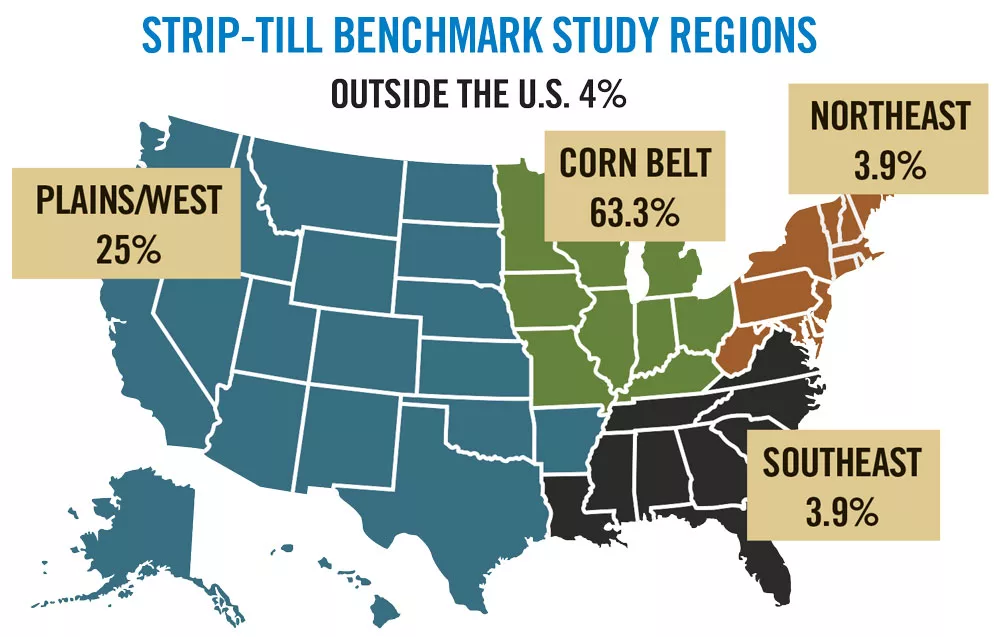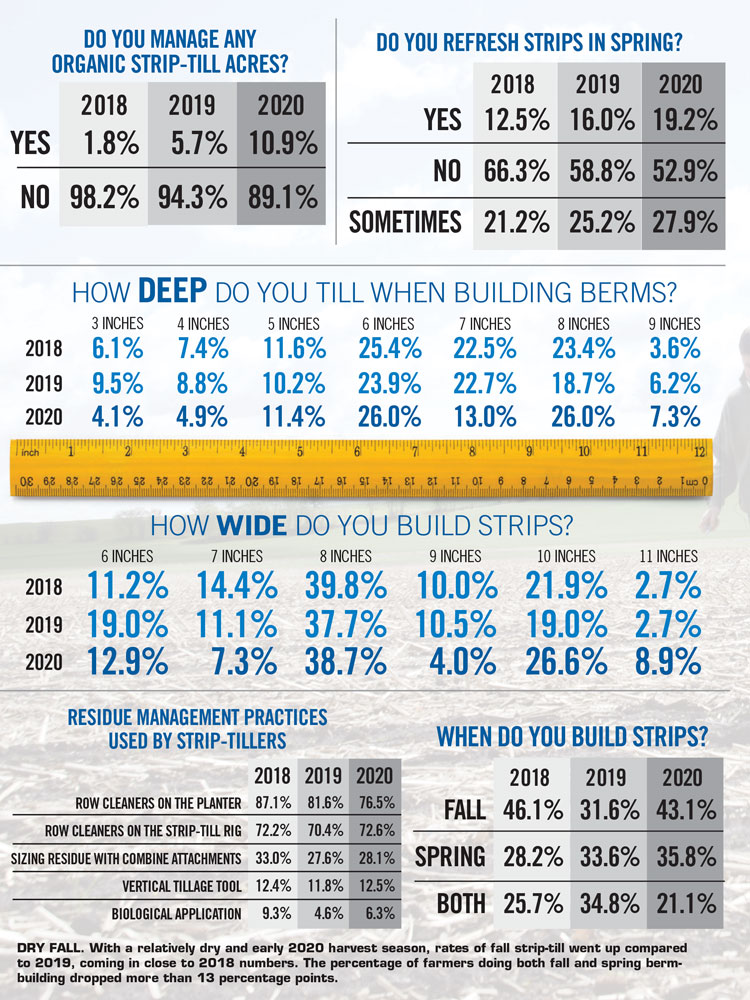Pictured Above: CENTRAL STATES. The vast majority of Strip-Till Benchmark Study responses came from the Corn Belt (63.3%), but the plains and western states were also well represented cumulatively at 25%.
Results of the 8th annual Strip-Till Operational Practices Benchmark study suggest a “return to normal” for many strip-tillers whose fall berm-building plans had been disrupted by wet, soggy weather in 2019.
In the following pages, we compare equipment setups, berm-building preferences, nutrient management strategies and other practices strip-tillers are putting to work on their operations.
Berm Building
This industry-exclusive study evaluating 2020 strip-till practices found that while the percentage of growers building berms in the fall decreased from 46.1% in 2018 and to 31.6% in 2019, the practice was back up to 43.1% in 2020 — but nowhere close to the 2017 high of 53.6%.
Spring berm-building also went up in 2020, though only slightly, from 33.6% in 2019 to 35.8%. Those who build berms in both fall and spring dropped to 21.1% in 2020 from 34.8% in 2019.
Overwhelmingly, strip-tillers favor 30-inch rows, with 84% of strip-tillers using that configuration. Twelve-row strip-till bars are most popular (38%), followed by 16-row (25%), 8-row (17%), 6-row (14%), and 24-row(5%). A majority (58%) are using shanks to build their strips, followed by a coulter system (40%) and mole knives (22%).
Trending Younger
The vast majority of survey respondents this year hailed from the central U.S., with more than 60% located in the Corn Belt states. The Plains and Western states were also well-represented at 25%, while a touch less than 8% were equally distributed from the Northeast and Southeast.
The demographics of strip-tillers responding to our survey suggest younger farmers are taking up the practice, as only 64% indicated they are 45 or older, a 9-point decrease from 2019.
In addition, 26% of growers indicated that 2020 was their first year strip-tilling, while 47.7% said they’ve been strip-tilling less than 5 years and more than 70% adopted the practice a decade ago or less. About 18% of respondents have been strip-tilling more than 15 years.
Among first-time strip-tillers, a full 60% were under 45, which at least in part explains the drop in average age.
Acreage and Yields
Looking at total cropping acres, the average farm size increased relative to 2019, with 43.8% indicating they farm 1,000 or fewer acres. By comparison, that figure was 52% in 2019 and 38.5% in 2018. However, the percentage of respondents farming more than 5,000 acres continues to rise, having increased from 3% in 2018 to 4.8% in 2019 and now to 6.3% in 2020.
Average strip-tilled corn yields fell 6 bushels to 196 bushels per acre, while soybean yields jumped up 4 bushels to 66 bushels per acre.
The average acreage being strip-tilled continued a downward trend in 2020, with respondents reporting 633 acres per farm of strip-tilled corn, down from 719 in 2019, 780 in 2018 and 921 in 2017.
Strip-tilled soybean acres also trended down, with an average of 435 in 2020 compared to 464 in 2019, 517 in 2018 and a high of 552 in 2017.
Organic adoption among strip-tillers continues its upward trajectory, with 11.7% managing some organic acres — up from 5.7% in 2019 and 1.8% in 2018.
Efficient Nutrient Management
Most strip-tillers have taken to targeted nutrient applications, with 75.8% applying nutrients multiple times during the year.
A full 89.5% sidedress nitrogen (N), mostly in conjunction with other applications. Of those who sidedress N, 35.7% also apply it while strip-tilling, 32% do it at-plant, and 21% do it pre-plant.










